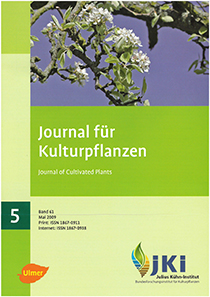Use of molecular markers for checking the hybrid formula and discriminating hybrid varieties in winter oilseed rape
DOI:
https://doi.org/10.5073/JfK.2009.05.02Keywords:
Variety discrimination, winter oilseed rape, hybrid varieties, molecular markersAbstract
Microsatellite markers were investigated with regard to their suitability to discriminate hybrid varieties of winter oilseed rape. To this end, 42 hybrids and their 54 parent lines were analysed with 27 microsatellite markers, the latter of which had been selected for good readability as well as polymorphism and were assessed by two independent laboratories using differing molecular-marker methodology. The DNA samples represented mixtures of 40 individual plants (per entry). The results demonstrate that in addition to the DNA marker patterns, knowledge of the variety type as well as of the hybrid parents is required as a prerequisite to check the hybrid formula for a given DNA sample. In some instances, heterogeneity or residual heterozygosity of parent lines at the SSR-marker level obscured inference of the variety type. Plausibility of the hybrid formula could be checked quite readily in cases where the parental lines were known and results were consistent among the two labs. The study demonstrates that detailed harmonization of methods between different laboratories is indispensable to obtain results which not only are consistent among labs but also unequivocal when assessing composite samples of oilseed rape via molecular markers.
Downloads
Published
Issue
Section
License
The content of the journal is licensed under the Creative Commons Attribution 4.0 License. Any user is free to share and adapt (remix, transform, build upon) the content as long as the original publication is attributed (authors, title, year, journal, issue, pages).
The copyright of the published work remains with the authors. The authors grant the Journal of Cultivated Plants, the Julius Kühn-Institut and the OpenAgrar repository the non-exclusive right to distribute and exploit the work.







